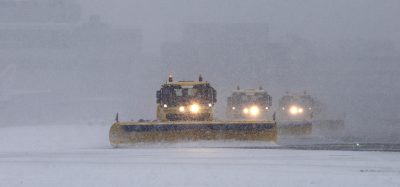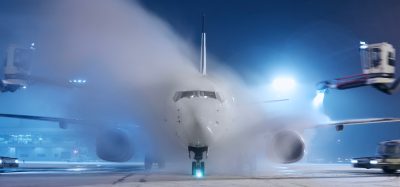The lights will be on
- Like
- Digg
- Del
- Tumblr
- VKontakte
- Buffer
- Love This
- Odnoklassniki
- Meneame
- Blogger
- Amazon
- Yahoo Mail
- Gmail
- AOL
- Newsvine
- HackerNews
- Evernote
- MySpace
- Mail.ru
- Viadeo
- Line
- Comments
- Yummly
- SMS
- Viber
- Telegram
- Subscribe
- Skype
- Facebook Messenger
- Kakao
- LiveJournal
- Yammer
- Edgar
- Fintel
- Mix
- Instapaper
- Copy Link
Posted: 11 September 2006 | Daniel Hartman, Airfield Manager, Ted Stevens Anchorage International Airport | No comments yet
How does an airport that experiences Arctic type weather consistently remain open? Daniel Hartman discusses the demands of an Alaskan winter, when ambient temperatures can fall as low as -38 degrees, with wind chills down to -60, equipment oil and hydraulic fluids are like thick syrup and starter heads blow apart when started.
How does an airport that experiences Arctic type weather consistently remain open? Daniel Hartman discusses the demands of an Alaskan winter, when ambient temperatures can fall as low as -38 degrees, with wind chills down to -60, equipment oil and hydraulic fluids are like thick syrup and starter heads blow apart when started.
The location of Ted Stevens Anchorage International Airport (IATA: ANC) less than 9 ½ hours by air from 90 per cent of the industrialised world, has enabled it to become the preeminent international cargo crossroad for transpacific freighter activity. It also demands faultless winter operations; average seasonal snowfall is 69 inches, with records as much as 132.8 inches. 24 hour snow accumulation has, in the past, reached 27.6 inches, other airports with more equipment and personnel have closed after receiving as little as two inches.
ANC officially opened in 1953, with an estimated 90 per cent of Alaska’s passenger traffic and 65 per cent of its mail transported by Anchorage-based airlines. In the 1960s, the airport established itself as the Air Crossroads of the World, with international passenger carriers using it as a stop-over on routes between Europe, Asia and the U.S. That increase in business spurred larger, re-engineered runways. By the late 1980s, Federal Express and UPS had established major transpacific sorting hubs in Anchorage. Today, the Airport is one of the fasted growing cargo airports in the United States, ranked #1 in the U.S. for landed cargo weight and #3 in the world for cargo throughput.
Development at the Airport includes the new C Concourse, a 447,200 square foot, nine-gate domestic concourse, opened in 2004, as well as upgrades to taxiways and the remodelling of the A & B Concourses. Federal Express and UPS are expanding their operations in Anchorage in preparation for the A380’s integration into their fleet, while a service company has leased property to construct a new sorting facility, in addition to nine parking spots for cargo aircraft. ANC is in the process of constructing three of these new parking hard stands; two that will be A380 capable Airbus. The growth will be furthered by future construction of hard stands.
ANC has not closed due to weather in over ten years and has never been closed for snow. The airport is a four time recipient of the national Balchen/Post award, recognising its field maintenance and operation workers for excellence in the performance of snow and ice control. They have also had 4 FAA Part 139 “0” Discrepancy Inspections.
There are numerous factors that account for this achievement. The first and most important is the caliber of the people that make up the Airfield Maintenance section. These workers are some of the most dedicated personnel that I have ever had the pleasure to supervise. There is no task too big or small for them to undertake and perform in an utmost professional manner. Being a 24 hour a day, seven day a week operation, each shift will comprise of 15 equipment operators, 4 mechanics and 2 electricians. Field Maintenance is responsible for snow removal on three major runways (each over 10,500 feet), three major taxiways and eighteen shorter taxiways and interlinks. They also maintain one of the largest general aviation seaplane airports in the world, ploughing a 2,200 foot gravel strip runway for wheeled aircraft and grooming two lakes for ski-equipped aircraft. In addition there are 62 miles of road lane and over 300 acres of aircraft and vehicle parking area.
When a snow storm starts, employees on the off shift often call in to ensure that there are adequate personnel on duty to fight the storm and keep the airport open. It is not uncommon for employees to report to work without being scheduled. Everyone has one job in mind: ensuring that incoming aircraft have a safe place to land. Everyone pulls together: operators and mechanics, as well as the field electricians, who are all trained and qualified to operate some types of snow removal equipment.
Our primary snow removal equipment consists of 7 plough trucks with twenty foot, front mounted ploughs, which pull high speed runway brooms. Several local modifications have been made on both the plough trucks and brooms to improve proficiency. The trucks were equipped with a multi-function joy stick to enable the operator to raise and lower the truck plough and the broom core utilising one control. This allows the operator to keep one hand on the wheel controlling the equipment while performing this function and prevents the broom from tracking into the berm when the plough blade is raised and not the broom core. The runway broom was modified with a broom core self adjusting system to ensure that the broom core is adjusted equally, equalising the wear on the brushes. Before the modification, the average life on a broom core was 46 hours of sweeping time. Now, the average time is well over 110 hours of sweeping. This not only saves core replacement cost, but also eliminates the need for the operator to stop sweeping to get out and adjust the broom sweeping pattern. What used to take valuable time from snow removal, now only requires the operator to check the brush sweeping pattern at the beginning of the shift.
Normal operation includes five plough trucks and brooms, two snow blowers, sand trucks or de-icing trucks and road graders in one pass on each side of the centre line. After the plough trucks have bermed up the snow to the point where it becomes hard to move, we place a snow blower to blow the snow out as far as possible. The placement of the blower will depend on the depth and consistency of the snow. Following the blower will be the remainder of plough trucks and brooms. Then a road grader berms up the snow for the last snow blower to blow the snow past the edge lights.
Afterwards, we follow up with either sand trucks or deicing trucks depending on weather conditions and air temperature. If it’s dry cold snow, we only apply sand. We want to keep the pavement dry to prevent the snow from sticking to the asphalt. If it is a wet snow, prill Urea or E36 is applied, depending on the ground and air temperature. Prill Urea works well for temperatures above 22 degrees Fahrenheit. It also works well in freezing rain conditions. It dissolves slow and provides longer lasting deicing than E36, which seems to dilute and wash away faster.
While the ploughs, brooms and other equipment are on the runways and taxiways, there will be as many as eight loaders with U blades pushing the snow off the aircraft parking ramps. During the St. Patrick’s Day snowstorm of March 18, 2002, 27.6 inches fell in just over 12 hours. We realised that we had problems keeping the ramps open. This caused the departing aircraft to take longer reaching the runway for take off, exceeding their allowable hold over time after being deiced. This required them to return to the gate for additional deicing. The problem was that the size of the loader did not weigh enough to maintain traction pushing the snow from the ramps to a temporary storage pile. To compensate for this lack of traction, the operators were only carrying about half of the U-blade capacity, which slowed the removal process down. To remedy this problem, three Loaders with 24 foot wide, 8 foot high U-blades were purchased. What used to take 38 hours to clean the ramps after a 10 inch snowstorm is now accomplished within 12 hours. We also built a pad close to the runway to store a tanker of deicing fluid, so that the aircraft carriers could deice close to the runway whenever the weather slowed down their normal taxi and takeoff time.
When we receive advance warning of a wet snowstorm, we will anti-ice the taxiways and runways with E36, using .75 gallons per square yard. This really helps prevent the snow from adhering to the paved surfaces and helps reduce the amount of chemicals needed to maintain friction requirements.
We have an agreement with the FAA control tower that allows us to go into continuous high speed snow removal operation when we start to receive snow. While in continuous operation, the airfield foreman coordinates directly with the tower to open and close runways for snow removal. The foreman will advise the tower controller when one runway will be finished and which runway will be next for snow removal. The tower will then start to shift incoming and out going traffic so that the snow removal crews can proceed to the next runway with very limited waiting time. When the equipment has cleared a runway that has just been cleaned and a friction test completed, the field foreman will relay this information to the tower controller and open the runway. If all the traffic has been shifted, the next runway will be closed and the crew will proceed to the runway without stopping. If not, the tower will allow any aircraft within 5 minutes of landing to land and aircraft that have already started their taxi for that runway to take off. All other traffic will be diverted to another runway. The runway will then be closed for snow removal. The average time to clear a runway and apply the necessary chemicals is about 22 minutes before it is reopened for traffic. By allowing the foreman to work directly with the tower and not through operations, the process is accelerated, ensuring that our snow removal equipment is clear of the runways while open and before reopening to traffic.
Snow removal at Anchorage, in some ways, is a year around project. We have experienced snowfalls with 2 or more inches of snow as early as mid September and as late as the middle of May. As soon as we are sure that we are out of snow season, the equipment repair section starts their work on readying the equipment for the next season. A complete inspection of every piece of equipment is accomplished before the next season, from as little as flushing the fluids and re-servicing, to a complete rebuild including re-powering with a new engine and electrical system. Our mechanics are experienced professionals; one is a highly trained machinist and another is a certified welder and welding inspector. They have been trained in the AutoCAD system, which enables them to design parts in the computer then manufacture it. Many hard to get parts can be made in either the welding shop or the machine shop. This also cuts down on a long lead time on parts that have to come from the lower 48 or overseas.
We have just completed construction of a new 114,000 sq. foot maintenance/warm storage building. We also recently constructed a 27,000 sq. foot, sand and Urea storage building, which can store enough products for the complete winter season and two liquid deicer storage tanks with 92,000 gallon storage capacity for E36. We have built a refuelling station with 12 diesel pumps and 4 gas pumps. This complete complex has been strategically located as close to the centre of the airfield as possible. This reduces the response time to the field, as well as the time it takes to replenish the sand and deicing trucks.
The prospect of the A380 or other Group VI aircraft flying through ANC creates new challenges for us. We are in the process of purchasing new equipment that will speed up our snow removal operation. A new snow blower is on order that will have the capability of blowing 10,000 tons of snow per hour. We are also looking at purchasing a machine designed to clear specifically around the edge light and signs.
One comment that we always like to hear from airline pilots is that they are not afraid to fly to Anchorage during the winter because they know when they get here, “The airport will be open, the lights will be on and they will have a safe place to land.”
Daniel Hartman
Daniel Hartman has been employed at the Ted Stevens Anchorage International Airport for over seven years, initially as the Assistant Airfield Manager and within a year as the Airfield Manager. He supervises 107 personnel and plans, coordinates, directs and manages airfield maintenance resources and activities associated with the Anchorage International/Lake Hood aviation complex in Anchorage. This includes functions of the airfield equipment maintenance shop, the maintenance and repair on roads, runways, taxiways, aircraft parking aprons and float plane parking slips in general aviation areas, as well as the maintenance of airfield electrical systems for both general aviation and international areas within the facilities. He is also responsible for snow removal throughout the airport. During this time he has overseen the construction of a new sand and Urea storage facility, a new combined refuelling facility and a ‘state of the art’ maintenance and warm storage complex. His field maintenance team has been the recipient of the Balchen/Post Award three times for outstanding snow and ice control. The airport has had ‘0’ discrepancies in 4 FAA Part 139 Certification Inspections under management.

















